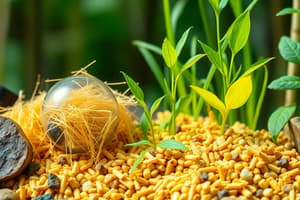Podcast
Questions and Answers
Why is the exploration of non-conventional energy resources, such as biomass, increasingly important?
Why is the exploration of non-conventional energy resources, such as biomass, increasingly important?
- Due to growing concerns about fossil fuel depletion and environmental impact. (correct)
- To solely replace conventional energy resources immediately.
- To avoid the need for any further development of conventional energy resources.
- Because non-conventional resources are cheaper to extract and process.
Which of the following materials aligns with the United Nations Framework Convention on Climate Change's definition of biomass?
Which of the following materials aligns with the United Nations Framework Convention on Climate Change's definition of biomass?
- Coal extracted from deep underground mines.
- Non-fossilized organic waste from agricultural processes. (correct)
- Petroleum refined into gasoline for vehicles.
- Plastics derived from petrochemical industries.
Why is energy derived from biomass considered carbon neutral?
Why is energy derived from biomass considered carbon neutral?
- Because burning biomass does not release any CO2.
- Because the CO2 released is immediately converted back into biomass.
- Because biomass is mixed with fossil fuels before combustion to neutralize emissions.
- Because the carbon in biomass originates from atmospheric CO2 absorbed during photosynthesis. (correct)
Which of the following is the most accurate description of how biomass is formed?
Which of the following is the most accurate description of how biomass is formed?
What distinguishes biomass from conventional energy resources like coal and petroleum?
What distinguishes biomass from conventional energy resources like coal and petroleum?
During photosynthesis, what key process occurs in green plants?
During photosynthesis, what key process occurs in green plants?
How is the energy content (calorific value) of biomass determined?
How is the energy content (calorific value) of biomass determined?
Which of the following materials is categorized as waste biomass?
Which of the following materials is categorized as waste biomass?
Why are fast-growing trees like poplar and eucalyptus cultivated?
Why are fast-growing trees like poplar and eucalyptus cultivated?
What products from sugarcane processing can be utilized for ethanol production?
What products from sugarcane processing can be utilized for ethanol production?
What is the initial determining factor when evaluating if a biological material/waste is appropriate for energy generation?
What is the initial determining factor when evaluating if a biological material/waste is appropriate for energy generation?
What role do cell walls play in plant structure?
What role do cell walls play in plant structure?
What is the primary function of lignin in plant cell walls?
What is the primary function of lignin in plant cell walls?
Which component of woody biomass is defined as substances separable by solvent extraction?
Which component of woody biomass is defined as substances separable by solvent extraction?
Which of the following is a characteristic of cellulose that affects its use for energy production?
Which of the following is a characteristic of cellulose that affects its use for energy production?
What is a key structural difference between cellulose and hemicellulose?
What is a key structural difference between cellulose and hemicellulose?
During gasification, why is biomass higher in hemicellulose preferred over biomass that is higher in cellulose?
During gasification, why is biomass higher in hemicellulose preferred over biomass that is higher in cellulose?
What distinguishes lignin from cellulose and hemicellulose in terms of its chemical composition?
What distinguishes lignin from cellulose and hemicellulose in terms of its chemical composition?
What are the primary precursors involved in the biosynthesis of lignin?
What are the primary precursors involved in the biosynthesis of lignin?
How does the lignin content typically vary between softwood and hardwood?
How does the lignin content typically vary between softwood and hardwood?
Flashcards
What is Biomass?
What is Biomass?
Organic material from plants and animals usable as an energy resource. Includes wood, crops, seaweed and animal waste.
Biomass Definition (UNFCCC)
Biomass Definition (UNFCCC)
Non-fossilized and biodegradable organic material from plants, animals, and microorganisms, including products, byproducts, residues, and wastes.
Photosynthesis
Photosynthesis
The process where plants absorb solar energy, carbon dioxide, and water to produce carbohydrates and release oxygen.
Biomass Formation
Biomass Formation
Signup and view all the flashcards
Maiden Biomass
Maiden Biomass
Signup and view all the flashcards
Waste Biomass
Waste Biomass
Signup and view all the flashcards
Energy Crops
Energy Crops
Signup and view all the flashcards
Biomass Composition
Biomass Composition
Signup and view all the flashcards
Extractives (Biomass)
Extractives (Biomass)
Signup and view all the flashcards
Cell Wall Components
Cell Wall Components
Signup and view all the flashcards
Ash (Biomass)
Ash (Biomass)
Signup and view all the flashcards
What is Cellulose?
What is Cellulose?
Signup and view all the flashcards
What is Hemicellulose?
What is Hemicellulose?
Signup and view all the flashcards
What is Lignin?
What is Lignin?
Signup and view all the flashcards
Study Notes
- Biomass is a key focus in the module due to its potential as an energy resource
- The module explores how to tap and utilize biomass for usable energy production
Importance of Non-Conventional Energy Resources
- Growing concerns about fossil fuel depletion and environmental impact necessitate exploring non-conventional energy resources
- Development of non-conventional energy resources is ongoing and will likely supplement, rather than replace, conventional resources
- Biomass is one example of a non-conventional energy resource to be discussed
- Biomass will be discussed in terms of its broad classification and composition
Definition of Biomass
- Biomass is organic material usable as an energy resource
- Examples of biomass include wood, crops, seaweed, and animal waste
- Biomass encompasses materials from plants and animals, including their waste and residues
- The United Nations Framework Convention on Climate Change defines biomass as:
- Non-fossilized and biodegradable organic material from plants, animals, and microorganisms
- Products, byproducts, residues, and waste from agriculture, forestry, and related industries
- Non-fossilized and biodegradable organic fractions of industrial and municipal wastes
- Gases and liquids recovered from the decomposition of non-fossilized and biodegradable organic materials
- Biomass is considered a sustainable energy resource due to its replenishment rate
Sustainability and Carbon Neutrality
- Biomass is constantly formed through the interaction of CO2, air, water, soil, and sunlight with plants and animals.
- Carbon in biomass comes from atmospheric CO2 via photosynthesis, not from fossil resources
- Emitted CO2 from burning or digesting biomass is recycled
- Energy from biomass is considered carbon neutral
Photosynthesis and Biomass Growth
- Biomass grows via photosynthesis, absorbing solar energy, carbon dioxide, and water
- Photosynthesis produces carbohydrates (plant cell walls) and releases oxygen
- Biomass includes living and recently dead biological species suitable for fuel or chemical production
Exclusions from Biomass Definition
- Biomass excludes organic material transformed into coal and petroleum over millions of years by geological processes.
- Coal and petroleum are conventional, non-renewable energy resources.
- Biomass mainly comes from botanical and biological resources, or a combination of both
Formation of Biomass
- Solar radiation incident on green plants and photosynthetic organisms facilitates chemical reactions and photosynthesis
- In green plants, photosynthesis converts atmospheric CO2 into carbohydrates like sugars, starches, celluloses, and hemicelluloses, using sunlight, chlorophyll, and water.
- X molecules of CO2 react with Y molecules of water in presence of sunlight, which is the photosynthesis process, and convert into carbohydrate plus oxygen
- 6 CO2 molecules react with 6 H2O molecules in the presence of radiant energy of the sun, and produce glucose + oxygen
- Chains of simple structures result in formation of complex hydrocarbons like sucrose, starch, and cellulose
- Respiration, the reverse of photosynthesis, produces CO2, water, and energy
Energy Absorption and Biomass Content
- The net rate of energy loss in respiration is less than the rate of energy gain during photosynthesis
- Net energy absorbed from solar radiation during photosynthesis can be calculated from its combustion process
- Delta Q is the enthalpy change of the combustion process
- Delta Q = (energy absorbed from photons of solar radiation) - (energy of respiration)
- Net value of delta Q is 4.8 electron volts per carbon atom
-
- 8 electron volts converts to 470 kilojoules per mole of carbon or 16 megajoules per kilogram of carbohydrate
- This value represents the energy content of biomass measured using a calorimeter (calorific value)
Types of Biomass
- Biomass types include maiden biomass and waste biomass
- Maiden biomass is also known as virgin or primary biomass
- Terrestrial: forest biomass, grasses, energy crops, cultivated crops
- Aquatic: seaweed, water hyacinth, algae
- Waste Biomass
- Agricultural Solid: livestock manures, agricultural crop residue
- Industrial: demolition of wood, sawdust, waste oil/fat
- Forest Residue: bark, leaves, floor residues
- Municipal Waste: municipal solid waste, bio solids, sewage
Classification Descriptions
- Agriculture crops: gasified for producer gas, or converted into solid fuel
- Forests: fuel wood, charcoal, producer gas
- Forest waste and residues utilized at the mill
- Fast growing trees such as poplar, pine, eucalyptus, switch grass, miscanthus are cultivated for energy
- Urban Waste:
- Municipal Solid Waste (MSW): combustion/incineration or landfill gas
- Sewage Sludge: converted into biogas
Energy Crops
- Sugar plants (sugar cane, sweet sorghum, sugar beet) are raw material for ethanol production
- Sugarcane processing yields molasses and bagasse, which can be used to form ethanol
- Sweet sorghum is sometimes supplied as a raw material when supply is not required in the sugar mill
- Starch plants such as cassava contain high amounts of starch
- Oil plants such as palm, soybean, rapeseed and groundnut produce waste oils which are used for energy
Aquatic Plants
- Some aquatic plants grow faster than land plants
- Examples include water hyacinth, seaweed and algae
Biological Material/Waste
- Animal waste, aquatic species and biological waste can be used for energy
- Biomass selection can be determined using a questionnaire to determine if it is appropriate for energy generation
- If other alternative viable options exist then the material is discarded
- Is the feedstock a byproduct of main crops or woody biomass? If not then it cannot be considered
- It is is a byproduct then the feedstock can be implemented for energy generation
Biomass Structure
- Biomass is a complex compound of carbohydrate, proteins, fats, and minerals (sodium, phosphorus, calcium, iron)
- Components of woody biomass are extractives, cell wall components (cellulose, hemicellulose, lignin), and ash
- Extractives are substances separable by solvent extraction
- Lipids and hydrocarbons which are soluble in ether, or various types of phenolic compounds, carbohydrates and protein collectively called extractives
- Leaves and bark contain more extractives and less cell wall material
- Cell walls provide structural strength to plants
- Cell walls are made of carbohydrate and lignin
- Carbohydrates are cellulose or hemicellulose and provides strength
- Lignin holds the fibers together
- Plant constituents vary from plant to plant
Biomass Composition and Structure
- Some plants, like corn, soybeans, and potatoes, store starch, a carbohydrate polymer that can be used as a raw material for ethanol production.
- Fats, found mainly in seeds and roots of seed-bearing plants, are a source of energy.
- Fatty acids in fats and oils are used to produce energy.
- Ash, the inorganic component of biomass, is usually present in minor amounts and comprises elements essential for plant growth.
Cell Wall Constituents
- Polymeric composition of cell walls varies widely but is primarily made up of cellulose, hemicellulose, and lignin.
- The cell walls are majorly made up of 3 polymers these are cellulose, hemicellulose and lignin.
Cellulose
- Cellulose is the world's most common organic biopolymer.
- Cellulose is a homo polysaccharide of glucose (C6 sugar units) and the main structural component of cell walls.
- Glucose can be obtained from cellulose biopolymer.
- Cellulose makes up 40-45% of wood by dry weight.
- Cellulose has a crystalline structure of thousands of glucose units, but this structure requires harsh pretreatment to break down for energy use.
- Cellulose is primarily composed of D glucose units.
- Cellulose is a major contributor of tar during the gasification of biomass; biomass with less cellulose and more hemicellulose is preferred for gasification.
Hemicellulose
- Hemicelluloses are hetero polysaccharides consisting of C5 and C6 sugars (Hexosans and Pentosans) found in plant cell walls.
- Cellulose and hemicellulose are fiber compounds in the cell wall, with lignin binding them together.
- Cellulose has a crystalline structure resistant to hydrolysis, while hemicellulose has a random, amorphous structure that is easily hydrolyzed.
- Hemicellulose serves as a cementing material in plant cell walls, holding together cellulose micelles and fibers.
- Composition and structure of hemicellulose varies from biomass to biomass.
- Hemicellulose contains simple sugar residues like D-xylose, D-glucose, D-galactose, L-arabinose, D-glucuronic acid, and D-mannose; it mainly contains D-xylose.
- Hemicelluloses are soluble in alkali and easily hydrolyzed by acids or alkali.
- Hemicellulose yields more gases and less tar than cellulose during gasification, making biomass with higher hemicellulose suitable for gasification.
- Softwood hemicellulose mainly contains galactoglucomannans and arabino glucoronoxylan (7-15%).
- Hardwood hemicellulose mostly contains xylan (10-35%).
- Hemicelluloses decompose more easily than cellulose, both thermo chemically and biochemically, due to less stable intra-molecular linkage.
- Hemicellulose accounts for about 20-35% of dry wood, 28% of softwood, and 35% of hardwood.
Lignin
- Lignin is one of the most abundant organic polymers on Earth and the third important constituent of woody biomass cell walls.
- Lignin is an amorphous, highly complex, mainly aromatic polymer of phenylpropane units.
- Unlike cellulose and hemicellulose, lignin does not contain any carbohydrate in its polymeric structure.
- Lignin does not have a single repeating unit like celluloses or hemicelluloses but consists of a complex arrangement of substituted phenolic units.
- The precursors of lignin biosynthesis are p coumaryl alcohol, coniferyl alcohol, and sinapyl alcohol.
- Lignin from softwoods (25-35%) mainly consists of a polymerization product of coniferyl alcohol, while lignin content in hardwoods ranges from 18-25%.
Studying That Suits You
Use AI to generate personalized quizzes and flashcards to suit your learning preferences.




